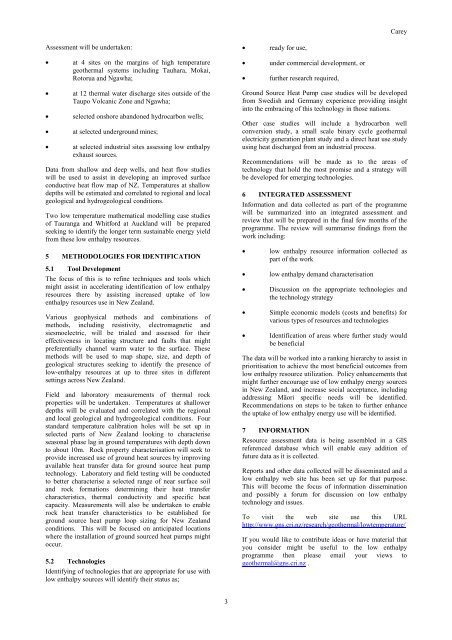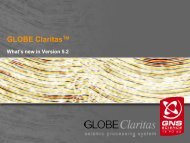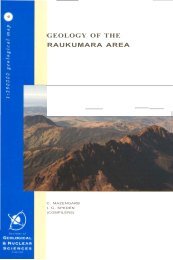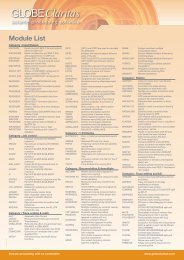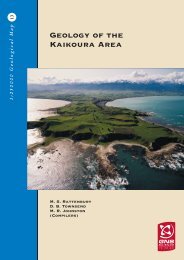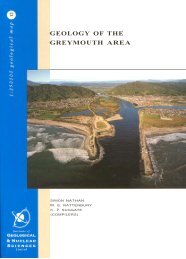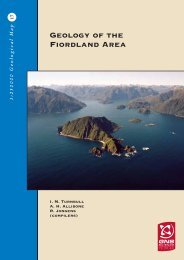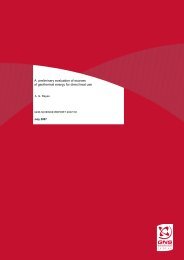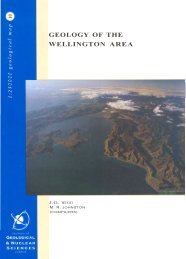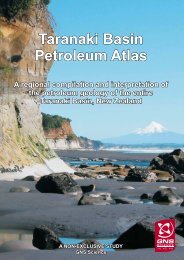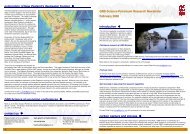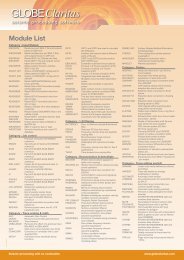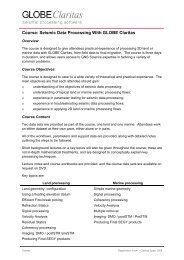Low Enthalpy Geothermal Research â New Zealand - GNS Science
Low Enthalpy Geothermal Research â New Zealand - GNS Science
Low Enthalpy Geothermal Research â New Zealand - GNS Science
Create successful ePaper yourself
Turn your PDF publications into a flip-book with our unique Google optimized e-Paper software.
CareyAssessment will be undertaken:• at 4 sites on the margins of high temperaturegeothermal systems including Tauhara, Mokai,Rotorua and Ngawha;• at 12 thermal water discharge sites outside of theTaupo Volcanic Zone and Ngawha;• selected onshore abandoned hydrocarbon wells;• at selected underground mines;• at selected industrial sites assessing low enthalpyexhaust sources.Data from shallow and deep wells, and heat flow studieswill be used to assist in developing an improved surfaceconductive heat flow map of NZ. Temperatures at shallowdepths will be estimated and correlated to regional and localgeological and hydrogeological conditions.Two low temperature mathematical modelling case studiesof Tauranga and Whitford at Auckland will be preparedseeking to identify the longer term sustainable energy yieldfrom these low enthalpy resources.5 METHODOLOGIES FOR IDENTIFICATION5.1 Tool DevelopmentThe focus of this is to refine techniques and tools whichmight assist in accelerating identification of low enthalpyresources there by assisting increased uptake of lowenthalpy resources use in <strong>New</strong> <strong>Zealand</strong>.Various geophysical methods and combinations ofmethods, including resistivity, electromagnetic andsiesmoelectric, will be trialed and assessed for theireffectiveness in locating structure and faults that mightpreferentially channel warm water to the surface. Thesemethods will be used to map shape, size, and depth ofgeological structures seeking to identify the presence oflow-enthalpy resources at up to three sites in differentsettings across <strong>New</strong> <strong>Zealand</strong>.Field and laboratory measurements of thermal rockproperties will be undertaken. Temperatures at shallowerdepths will be evaluated and correlated with the regionaland local geological and hydrogeological conditions. Fourstandard temperature calibration holes will be set up inselected parts of <strong>New</strong> <strong>Zealand</strong> looking to characteriseseasonal phase lag in ground temperatures with depth downto about 10m. Rock property characterisation will seek toprovide increased use of ground heat sources by improvingavailable heat transfer data for ground source heat pumptechnology. Laboratory and field testing will be conductedto better characterise a selected range of near surface soiland rock formations determining their heat transfercharacteristics, thermal conductivity and specific heatcapacity. Measurements will also be undertaken to enablerock heat transfer characteristics to be established forground source heat pump loop sizing for <strong>New</strong> <strong>Zealand</strong>conditions. This will be focused on anticipated locationswhere the installation of ground sourced heat pumps mightoccur.5.2 TechnologiesIdentifying of technologies that are appropriate for use withlow enthalpy sources will identify their status as;• ready for use,• under commercial development, or• further research required,Ground Source Heat Pump case studies will be developedfrom Swedish and Germany experience providing insightinto the embracing of this technology in those nations.Other case studies will include a hydrocarbon wellconversion study, a small scale binary cycle geothermalelectricity generation plant study and a direct heat use studyusing heat discharged from an industrial process.Recommendations will be made as to the areas oftechnology that hold the most promise and a strategy willbe developed for emerging technologies.6 INTEGRATED ASSESSMENTInformation and data collected as part of the programmewill be summarized into an integrated assessment andreview that will be prepared in the final few months of theprogramme. The review will summarise findings from thework including:• low enthalpy resource information collected aspart of the work• low enthalpy demand characterisation• Discussion on the appropriate technologies andthe technology strategy• Simple economic models (costs and benefits) forvarious types of resources and technologies• Identification of areas where further study wouldbe beneficialThe data will be worked into a ranking hierarchy to assist inprioritisation to achieve the most beneficial outcomes fromlow enthalpy resource utilization. Policy enhancements thatmight further encourage use of low enthalpy energy sourcesin <strong>New</strong> <strong>Zealand</strong>, and increase social acceptance, includingaddressing Māori specific needs will be identified.Recommendations on steps to be taken to further enhancethe uptake of low enthalpy energy use will be identified.7 INFORMATIONResource assessment data is being assembled in a GISreferenced database which will enable easy addition offuture data as it is collected.Reports and other data collected will be disseminated and alow enthalpy web site has been set up for that purpose.This will become the focus of information disseminationand possibly a forum for discussion on low enthalpytechnology and issues.To visit the web site use this URLhttp://www.gns.cri.nz/research/geothermal/lowtemperature/If you would like to contribute ideas or have material thatyou consider might be useful to the low enthalpyprogramme then please email your views togeothermal@gns.cri.nz .3


